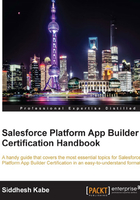
Chapter 3. User Interface
In the previous chapter, we created some objects for our fictional library. While a library is easy to relate with, in an enterprise-level data-centric solution, we need to deal with a lot more complex objects, such as Orders, Opportunities, and Accounts. Some of these objects are accessed by different people at different locations and different times. For example, a sales representative would like to know how much an Account is worth before going for a business meeting for a new product, but a customer service representative would like to know about the product or Service Level Agreement of the same account to service them better.
To access the object, the representatives will need tabs with a clear indication of what the object is. To determine who sees what part of the same object, we create separate page layouts for the object.
In the next chapter, we will see a much more granular way of controlling sensitive information. In this chapter, however, we will see one way of doing this using the user interface.
The objects that we created in the previous chapter need an equally rich UI for users to fill in data. They need placeholders and visual indicators to collect this data and the information.
Our primary focus in this chapter is on creating beautiful user interfaces. In this chapter, we will be using point-and-click controls to create some important page layouts and UI designs.
By the end of this chapter, you will be able to:
- Create tabs for easier navigation
- Create forms for data input
- Create page layouts to display the right data
- Bring them all together and build an application
So, let's start by creating some amazing user interfaces.